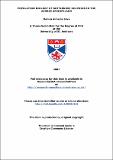Files in this item
Population biology of bottlenose dolphins in the Azores archipelago
Item metadata
| dc.contributor.advisor | Hammond, Philip S. | |
| dc.contributor.advisor | Santos, Ricardo Serrão | |
| dc.contributor.author | Silva, Monica Almeida | |
| dc.coverage.spatial | 270 | en |
| dc.date.accessioned | 2007-03-06T14:10:58Z | |
| dc.date.available | 2007-03-06T14:10:58Z | |
| dc.date.issued | 2007-06 | |
| dc.identifier | uk.bl.ethos.551966 | |
| dc.identifier.uri | https://hdl.handle.net/10023/215 | |
| dc.description.abstract | The ranging behaviour, habitat preferences, genetic structure, and demographic parameters of bottlenose dolphins living in the Azores were studied using data collected from 1999 to 2004. Only 44 dolphins out of 966 identified were frequently sighted within and between years and showed strong site fidelity. The remaining individuals were either temporary migrants from within or outside the archipelago, or transients. Estimates of home range size were three times larger than previously reported for this species, possibly as a result of the lower availability of food resources. Mitochondrial DNA sequences showed very high gene and nucleotide diversity. There was no evidence of population structuring within the Azores. The Azorean population was not differentiated from the pelagic population of the Northwest Atlantic, suggesting the "unproductive" waters of the Atlantic do not constitute a barrier to dispersal. Population size, survival and temporary emigration rates were estimated using open-population models and Pollock's robust design. A few hundreds of dolphins occur in the area on a given year, though the majority should use it temporarily, as suggested by the high emigration rates. Bottlenose dolphins preferentially used shallow areas with high bottom relief. Temporal and spatial persistence of dolphin-habitat associations documented in this study further supports the idea of a close relationship between certain bathymetric features and important hydrographic processes and suggests the occurrence of prey aggregations over these areas may be, to some extent, predictable. Several results of this study suggest there are no reasons for concern about the status of this population. Yet, the resident group may be negatively affected by increasing pressure from the whale watching activity. Although the proposed Marine Park constitutes important habitat for resident dolphins, at present, the area is clearly insufficient to satisfy their spatial requirements and its conservation value may be limited. | en |
| dc.format.extent | 2522007 bytes | |
| dc.format.mimetype | application/pdf | |
| dc.language.iso | en | en |
| dc.publisher | University of St Andrews | |
| dc.rights | Creative Commons Attribution-NonCommercial-NoDerivs 2.5 Generic | |
| dc.rights.uri | http://creativecommons.org/licenses/by-nc-nd/2.5/ | |
| dc.subject | Cetaceans | en |
| dc.subject | Bottlenose dolphins | en |
| dc.subject | Photo-identification | en |
| dc.subject | Ranging behaviour | en |
| dc.subject | Capture-recapture methods | en |
| dc.subject | Demographic parameters | en |
| dc.subject | Habitat modelling | en |
| dc.subject | Distribution | en |
| dc.subject | Population structure | en |
| dc.subject | Genetic structure | en |
| dc.subject | Conservation | en |
| dc.subject.lcc | QL737.C432S5 | |
| dc.subject.lcsh | Bottlenose dolphin--Azores | en |
| dc.subject.lcsh | Bottlenose dolphin--Genetics--Azores | en |
| dc.subject.lcsh | Bottlenose dolphin--Conservation--Azores | en |
| dc.subject.lcsh | Cetacea populations--Azores | en |
| dc.subject.lcsh | Population biology | en |
| dc.title | Population biology of bottlenose dolphins in the Azores archipelago | en |
| dc.type | Thesis | en |
| dc.contributor.sponsor | Fundação para a Ciência e Tecnologia (Portugal) | en |
| dc.type.qualificationlevel | Doctoral | en |
| dc.type.qualificationname | PhD Doctor of Philosophy | en |
| dc.publisher.institution | The University of St Andrews | en |
| dc.publisher.department | Sea Mammal Research Unit, School of Biology | en |
This item appears in the following Collection(s)
Except where otherwise noted within the work, this item's licence for re-use is described as Creative Commons Attribution-NonCommercial-NoDerivs 2.5 Generic
Items in the St Andrews Research Repository are protected by copyright, with all rights reserved, unless otherwise indicated.


